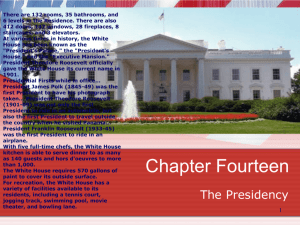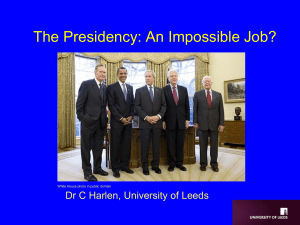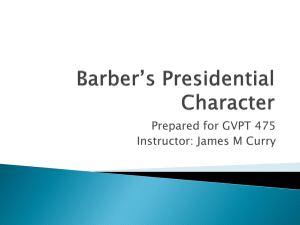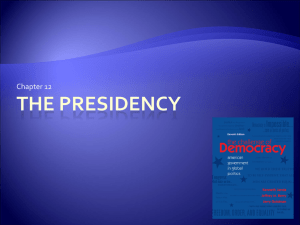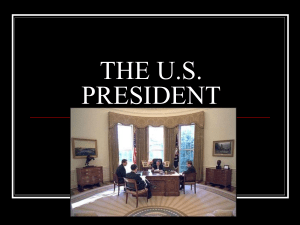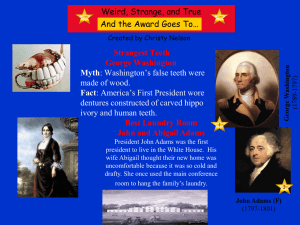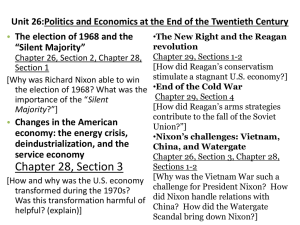Chapter 9: Presidential Powers
advertisement
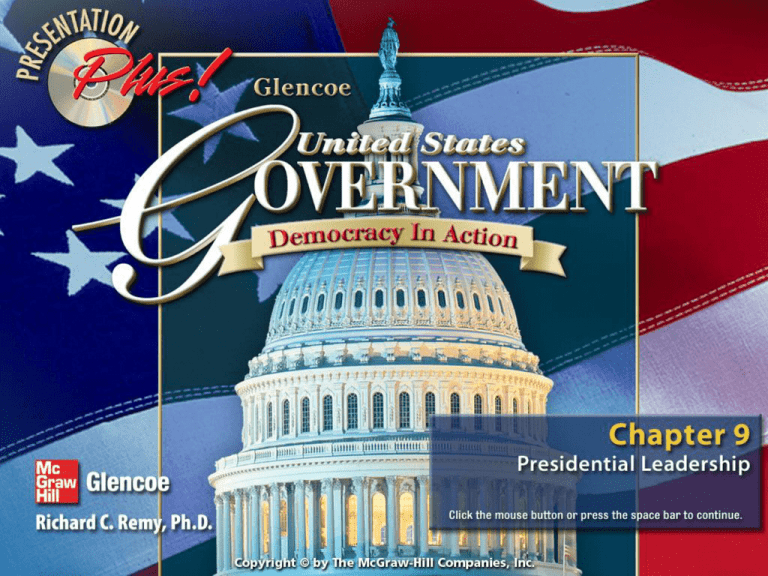
Chapter Focus Section 1 Presidential Powers Section 2 Roles of the President Section 3 Styles of Leadership Chapter Assessment Strong presidents sometimes defy even the Supreme Court. President Andrew Jackson was determined to force Native Americans in the Southeast to move west to the Oklahoma Territory. When Chief Justice Marshall ruled that the Cherokee nation’s treaty with Georgia protected its rights and property, Jackson reportedly refused to accept the decision.” John Marshall has made his decision. Now let him enforce it,” Jackson reportedly said. He ignored the Court and carried out the Indian Removal Act passed by Congress in 1830. I. Constitutional Powers (pages 245–247) A. The Founders recognized the need for a strong executive branch to overcome the weaknesses of the Confederation government and to hold the legislative branch in check. II. Informal Sources of Power (pages 247–249) A. Presidents have added to their powers by their actions; for example, Theodore Roosevelt declared his intent to do anything the needs of the nation required if such action was not expressly forbidden by the Constitution. B. During national crises, presidents like Abraham Lincoln, Franklin D. Roosevelt, and George W. Bush greatly expanded the powers of the presidency as the federal government dealt with dangers facing the United States. III. Limits of Presidential Power (pages 249–250) A. The Constitution gives Congress the power to limit presidential authority by overriding a veto or impeaching and removing the president from office for clear abuse of power. III. Limits of Presidential Power (pages 249–250) D. Public opinion can limit the president’s actions, as it did with President Lyndon Johnson’s policies in Vietnam and President Clinton’s proposed national health care program. III. Limits of Presidential Power (pages 249–250) Checking for Understanding 3. Identify War Powers Act. The War Powers Act prevents presidents from committing troops to combat for more than 60 days without congressional approval. Former President George Bush, who led the nation to victory in the Persian Gulf War in 1991, made a parachute jump as a personal fiftieth anniversary celebration in 1997. As a Navy pilot, Bush had escaped death in World War II by parachuting into the Pacific after his plane was shot down by the Japanese. I. As head of state, the president: (page 252) A. represents the nation at ceremonial functions; B. is considered more than a politician, but rather a symbol of the entire United States. II. As chief executive, the president: (pages 253–254) A. heads the 2 million person executive branch; B. influences how laws are executed through executive orders, presidential appointments, removal of appointed officials. C. grants pardons, or amnesty. III. As chief legislator, the president: (pages 254–255) A. proposes legislation to Congress, usually in the State of the Union Address; B. must work harder for congressional support when Congress is controlled by the opposition party; C. may use political favors to gain congressional support; D. has the threat of the veto to influence Congress. VI.As chief diplomat, the president: (pages 257–258) A. directs foreign policy and oversees foreign affairs information agencies; B. has sole power to make treaties, with Senate approval!!!!!!! C. has the sole power to recognize foreign governments. I. Increased Responsibilities (pages 261–262) A. Modern presidents have provided strong leadership for the nation, even though the Founders expected Congress to lead the nation. B. Presidents provide leadership in introducing bold new ideas as well as responding to crises at home and abroad. II. Leadership Qualities and Skills (pages 262–264) D. Successful presidents must: 1. be flexible and open to new ideas; 2. be able to compromise; 3. have political courage and be willing to go against public opinion in matters they believe are vital to the nation’s interests. Checking for Understanding 3. Identify executive privilege, United States v. Nixon. Executive privilege is the right of the president and other high-ranking executive officers to refuse to testify before Congress or a court. United States v. Nixon is the Supreme Court case that rejected President Nixon’s claim of executive privilege and unanimously ruled that the president had to surrender secretly taperecorded conversations about the Watergate cover-up to the special prosecution investigating the scandal. Checking for Understanding 4. How do presidents test public opinion before announcing new policies? A presidential aide leaks information about an issue to the press so the president can observe public reaction before actually announcing the policy. Recalling Facts 4. Why can failing to understand the public’s mood weaken a president’s power? The president may lose public support. Without the leverage of public support, relations with Congress will be difficult and the president’s effectiveness will diminish. 5. How do presidents become isolated? Most information comes through close aides who screen out what they do not want the president to hear. Thus, the flow of information and ideas to the president may be severely limited. Also, presidents may isolate themselves by discouraging opposing opinions or unwanted advice. 1) John F. Kennedy, Franklin D. Roosevelt, Lyndon B. Johnson, Richard M. Nixon, and Ronald Reagan 2) They all represent issues Clinton has faced. 3) These former presidents each faced an issue similar to the ones Clinton faced. Hail to the Chief When physically unimpressive President James K. Polk entered a room, he sometimes went unnoticed. His wife, Sarah, decided to ensure him of a president’s welcome by requesting the marine band to play “Hail to the Chief,” an old Scottish anthem, when he arrived. The tradition has lasted to this day. Watergate, originally used to describe the 1972 illicit entry into the Democratic Party national headquarters in the Watergate complex in Washington, D.C., has inspired countless, mostly short-lived words ending in “gate,” such as Koreagate, nannygate, Irangate, and Whitewatergate. The Buck Stopped There As commander in chief during World War II, President Harry Truman’s most difficult decision may have been whether to drop an atomic bomb on Japan. He knew such a bomb would result in terrible loss of life, mostly civilian. The long-term effects of radiation were also a concern. But Truman believed that defeating Japan would require a full-scale invasion, resulting in a great loss of American lives. Ultimately, Truman ordered bombs to be dropped on two Japanese cities, Hiroshima and Nagasaki. Debate over his decision continues today. Commanding the Military Some presidents, such as Bill Clinton, have had no military experience. In fact, in the 1992 presidential campaign, critics accused Clinton of cutting ethical corners to avoid the draft during the Vietnam War. Discuss the assets and liabilities of having a president with a military background, and one who has not served in the military. Gerald R. Ford President Gerald R. Ford is the only president to serve as both vice president and president without having been elected to either office. In an effort to put the Watergate scandal to rest, he pardoned former President Richard Nixon. The pardon created a backlash of negative public opinion. Ford’s popularity rating plunged from 71 percent to 50 percent. People suspected that Ford had struck a bargain with Nixon: Nixon would resign, Ford would become president and pardon Nixon. He never regained the public’s confidence as president. Lyndon B. Johnson President Lyndon B. Johnson liked to take a nap every day after lunch and sometimes invited a few top reporters to interview him right up until he fell asleep. These interviews usually began with an impromptu invitation to lunch in the family quarters. Johnson would give an off-the-record talk through the meal. Then he would signal the reporters to follow him to his bedroom, where he would change for his nap, talking all the while. Finally the president fell asleep and the reporters rushed off to report what he had said.



